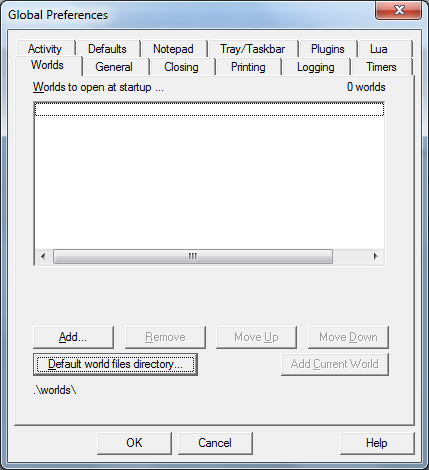

MUSHClient has a registry key for each user on a Windows 7 system at
HKEY_CURRENT_USER\Software\Gammon Software Solutions.
Beneath that key is HKEY_CURRENT_USER\Software\Gammon Software
Solutions\MUSHclient\Global prefs, which contains default
locations for directories.
| Name | Type | Data |
|---|---|---|
| (Default) | REG_SZ | (value not set) |
| DefaultLogFileDirectory | REG_SZ | C:\Program Files\MUSHclient\logs\ |
| DefaultWorldFileDirectory | REG_SZ | C:\Program Files\MUSHclient\worlds\ |
| PluginsDirectory | REG_SZ | C:\Program Files\MUSHclient\worlds\plugins\ |
If, within MUSHCient, you click on File, then Global Preferences, then click on the Worlds tab, then click on the Default world files directory, you can change the value for the directory where it looks for its world configuration files, which are .MCL, i.e. MUSHClient World Information files.
If you wish, you can specify a shared network location,
so that multiple systems can use the same World Information
files, e.g. \\MyServer\Shared\MUSHClient\worlds.

You would think that changing the value for Global Preferences
by that method would change the registry keys noted above. However,
it does not. Instead, the information is stored in an
mushclient_prefs.sqlite file at
C:\Users\username\AppData\Local\VirtualStore\Windows\System32\mushclient_prefs.sqlite,
where username is the Windows account name under which you are making the change.
When, I noticed that the registry keys remained the same even after I had
changed the default location, I discovered that is the file where information
was stored by filtering on all events associated with the process name
MUSHClient.exe while running
Process Monitor, a free utility for process monitoring from Microsoft.
I saw that that the program was opening
C:\Users\username\AppData\Local\VirtualStore\Windows\System32\mushclient_prefs.sqlite.
I looked at that file with
FileAlyzer.
When I opened mushclient_prefs.sqlite with that program,
clicked on the Hex dump tab and then chose List strings,
I saw the DefaultWorldFileDirectory pointing to the
shared network location I had selected.
An .sqlite file is a database file. It is created with SQLite, a self-contained, embedded database management system (DBMS). SQLite stores data in tables, which may each contain multiple fields and data types, which can be accessed via SQL commands using any system that supports SQLite.
You can download an sqlite_analyzer.zip file from
the SQLite Download Page.
Unzip the file and run the .exe file within it from a command line.
C:\Program Files\Utilities\Database\SQLite>sqlite3_analyzer.exe "C:\Users\Jane\AppData\Local\VirtualStore\Windows\System32\mushclient_prefs.sqlite" >mush_client_pres-analysis.txt
You can see the results for this particular case in the output file mush_client_pres-analysis.txt.
You can also view information on the data within the file
by downloading the sqlite command line program for accessing and modifying
SQLite databases from the same URL. Unzip the contents of the zip file and
then run the sqlite3.exe program from a command line.
See Command Line Shell For
SQLite for commands that you can use within the program.
C:\Program Files\Utilities\Database\SQLite>sqlite3 "C:\Users\Jane\AppData\Local\ VirtualStore\Windows\System32\mushclient_prefs.sqlite" SQLite version 3.6.20 Enter ".help" for instructions Enter SQL statements terminated with a ";" sqlite>
You can view the tables in the database file using the .tables
command.
sqlite> .tables control prefs worlds
I can see what the columns are in a table, such as the prefs
table using the .schema command.
sqlite> .schema prefs CREATE TABLE prefs (name VARCHAR(50) NOT NULL PRIMARY KEY, value TEXT NOT NULL ) ;
I can see that there is a column titled name and see what
entries are in that column with select name from prefs;.
sqlite> select name from prefs; AllTypingToCommandWindow AlwaysOnTop AppendToLogFiles AutoConnectWorlds AutoExpandConfig FlatToolbars AutoLogWorld BleedBackground ColourGradientConfig ConfirmBeforeClosingMXPdebug ConfirmBeforeClosingMushclient ConfirmBeforeClosingWorld ConfirmBeforeSavingVariables ConfirmLogFileClose EnableSpellCheck AllowLoadingDlls F1macro FixedFontForEditing NotepadWordWrap NotifyIfCannotConnect ErrorNotificationToOutputWindow NotifyOnDisconnect OpenActivityWindow OpenWorldsMaximised WindowTabsStyle ReconnectOnLinkFailure RegexpMatchEmpty ShowGridLinesInListViews SmoothScrolling SmootherScrolling DisableKeyboardMenuActivation TriggerRemoveCheck NotepadBackColour NotepadTextColour ActivityButtonBarStyle AsciiArtLayout DefaultInputFontHeight DefaultInputFontItalic DefaultInputFontWeight DefaultOutputFontHeight Icon Placement Tray Icon ActivityWindowRefreshInterval ActivityWindowRefreshType ParenMatchFlags PrinterFontSize PrinterLeftMargin PrinterLinesPerPage PrinterTopMargin TimerInterval FixedPitchFontSize AsciiArtFont DefaultAliasesFile DefaultColoursFile DefaultInputFont DefaultLogFileDirectory DefaultMacrosFile DefaultOutputFont DefaultTimersFile DefaultTriggersFile DefaultWorldFileDirectory NotepadQuoteString PluginList PluginsDirectory PrinterFont TrayIconFileName WordDelimiters WordDelimitersDblClick WorldList LuaScript Locale FixedPitchFont sqlite>
I can find the value for DefaultWorldFileDirectory with
the command select * from prefs where name='DefaultWorldFileDirectory';
.
sqlite> select * from prefs where name='DefaultWorldFileDirectory'; DefaultWorldFileDirectory|\\MyServer\Shared\MUSHClient\worlds
References: